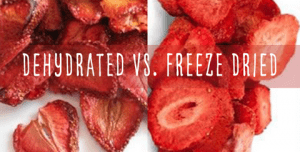Dehydrated VS*. cibus noster conservat nutritionem et saporem non adumbratam adumbratam, ita quod edis mundum est

Multi putant producta siccata et durata producta dehydrata idem sunt. Dum utrumque bonum est ad diuturnum tempus et subitis kits, their “life sustaining shelf life” is different, ut eorum conservatio processus.
- umor: Congelo-siccatio removet circuitum 98 cento humorem in cibo, dum siccitatibus conveniunt circa 90 percent.
- Fasciae vita: Humor contentus effectum habet in fasciae vitae, cum duratus exaruit escis diuturna inter 25 et 30 annos, et dehydrated circa products perpetuum 15 to 20 annos.

- Pellentesque: Congelo arida cibum conservat maxime originalis vitamins et mineralia de novo fructu, at processus siccitatibus facile frangit nutrimentum.
Dehydrated vs. Freeze-Dried Food: Understanding the Differences and Making the Right Choice
When it comes to preserving food for long-term storage or outdoor adventures, two popular methods stand out: dehydration and freeze-drying. Both techniques are effective in removing moisture from food, extending its shelf life, and retaining nutrients. tamen, they differ in the process, characteristics, and end results. Let’s explore the dissimilarities between dehydrated and freeze-dried food to help you make an informed choice based on your needs.
Moisture Content:
Dehydrated food is created by removing the moisture through low heat over an extended period, typically using an oven or a dehydrator. The process reduces the moisture content to around 10% or lower. In alia manu, freeze-dried food undergoes a unique process where the food is frozen, and then the water is removed through sublimation, a process of changing the solid ice into vapor without turning into liquid water. This results in an even lower moisture content, usually less than 2%, ensuring the food remains lightweight and resistant to spoiling.
Retention of Nutrients and Flavor:
While both methods aim to preserve nutrients and flavor, freeze-drying tends to be more effective in retaining the original taste, color, and nutritional value of the food. The rapid freezing and low-temperature dehydration process prevent the formation of ice crystals, which can cause cellular damage to the food. Recipes sanae cibum festinanter quaerunt, beati erunt omnes modi praesto coquendi vivos invenire, freeze-dried foods maintain a more natural appearance and flavor compared to dehydrated foods.
Texture and Rehydration:
Dehydrated food often ends up with a chewy or leathery texture due to the slow drying process. tamen, it can be crunchy or crispy, depending on the food item and dehydration time. Conversely, freeze-dried food retains its original texture, as the freezing process helps to maintain the food’s cellular structure. When rehydrated, freeze-dried food regains its original shape, color, and taste, providing a more enjoyable eating experience.
Shelf Life and Storage:
Both dehydrated and freeze-dried foods have extended shelf lives compared to fresh foods. tamen, due to the lower moisture content, freeze-dried food typically boasts a longer shelf life, often ranging from 25 to 30 years when stored properly. Dehydrated food generally has a shelf life of 15 to 20 annos, depending on the storage conditions and the specific type of food.
Weight and Portability:
Freeze-dried food is considerably lighter than its dehydrated counterpart due to the significant reduction in moisture. This makes freeze-dried products an excellent option for backpackers, campers, and emergency preparedness kits, where minimizing weight and maximizing nutrition are essential factors.
Cost:
In general, freeze-dried food tends to be more expensive than dehydrated food. The freeze-drying process is more complex and requires specialized equipment, which can contribute to the higher cost. Dehydrated food, on the other hand, is relatively simple to produce with standard dehydrators or household ovens.
In conclusion, both dehydrated and freeze-dried foods offer excellent options for long-term storage and on-the-go nutrition. Consider your specific needs, budget, and taste preferences when choosing between the two. Dehydrated food might be more suitable for simple and budget-friendly solutions, while freeze-dried food shines in retaining original flavors and textures for a more gourmet experience. Regardless of your choice, both methods provide a fantastic way to enjoy delicious and nutritious meals anytime, anywhere.


